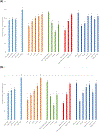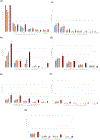Patterns of Prescription Medication Use during the First Trimester of Pregnancy in the United States, 1997-2018
- PMID: 37356083
- PMCID: PMC10949220
- DOI: 10.1002/cpt.2981
Patterns of Prescription Medication Use during the First Trimester of Pregnancy in the United States, 1997-2018
Abstract
The objective of this analysis was to describe patterns of prescription medication use during pregnancy, including secular trends, with consideration of indication, and distributions of use within demographic subgroups. We conducted a descriptive secondary analysis using data from 9,755 women whose infants served as controls in two large United States case-control studies from 1997-2011 and 2014-2018. After excluding vitamin, herbal, mineral, vaccine, i.v. fluid, and topical products and over-the-counter medications, the proportion of women that reported taking at least one prescription medication in the first trimester increased over the study years, from 37% to 50% of women. The corresponding proportions increased with increasing maternal age and years of education, were highest for non-Hispanic White women (47%) and lowest for Hispanic women (24%). The most common indication for first trimester use of a medication was infection (12-15%). Increases were observed across the years for medications used for indications related to nausea/vomiting, depression/anxiety, infertility, thyroid disease, diabetes, and epilepsy. The largest relative increase in use among women was observed for medications to treat nausea/vomiting, which increased from 3.8% in the earliest years of the study (1997-2001) to 14.8% in 2014-2018, driven in large part by ondansetron use. Prescription medication use in the first trimester of pregnancy is common and increasing. Many medical conditions require treatments among pregnant women, often involving pharmacotherapy, which necessitates consideration of the risk and safety profiles for both mother and fetus.
© 2023 The Authors. Clinical Pharmacology & Therapeutics © 2023 American Society for Clinical Pharmacology and Therapeutics.
Conflict of interest statement
CONFLICT OF INTEREST
Dr. Mitchell is a member of the Pregnancy Advisory Board for Biogen’s Tecfidera Pregnancy Registry. Dr. Werler serves as a diagnostic adjudicator for Novartis pregnancy registries. All other authors declared no competing interests for this work.
Figures


Similar articles
-
Trends in first-trimester nausea and vomiting of pregnancy and use of select treatments: Findings from the National Birth Defects Prevention Study.Paediatr Perinat Epidemiol. 2021 Jan;35(1):57-64. doi: 10.1111/ppe.12705. Epub 2020 Jul 4. Paediatr Perinat Epidemiol. 2021. PMID: 32623767 Free PMC article.
-
Ondansetron use in nausea and vomiting during pregnancy: A descriptive analysis of prescription patterns and patient characteristics in UK general practice.Br J Clin Pharmacol. 2022 Oct;88(10):4526-4539. doi: 10.1111/bcp.15370. Epub 2022 May 17. Br J Clin Pharmacol. 2022. PMID: 35483963 Free PMC article.
-
Ondansetron for Treatment of Nausea and Vomiting of Pregnancy and the Risk of Specific Birth Defects.Obstet Gynecol. 2018 Aug;132(2):385-394. doi: 10.1097/AOG.0000000000002679. Obstet Gynecol. 2018. PMID: 29995744
-
Folic acid supplementation and malaria susceptibility and severity among people taking antifolate antimalarial drugs in endemic areas.Cochrane Database Syst Rev. 2022 Feb 1;2(2022):CD014217. doi: 10.1002/14651858.CD014217. Cochrane Database Syst Rev. 2022. PMID: 36321557 Free PMC article.
-
ACOG Practice Bulletin No. 189: Nausea And Vomiting Of Pregnancy.Obstet Gynecol. 2018 Jan;131(1):e15-e30. doi: 10.1097/AOG.0000000000002456. Obstet Gynecol. 2018. PMID: 29266076 Review.
Cited by
-
The effect of pregnancy-related hormones on hepatic transporters: studies with premenopausal human hepatocytes.Front Pharmacol. 2024 Aug 7;15:1440010. doi: 10.3389/fphar.2024.1440010. eCollection 2024. Front Pharmacol. 2024. PMID: 39170705 Free PMC article.
-
Safety and Efficacy of Antiviral Drugs and Vaccines in Pregnant Women: Insights from Physiologically Based Pharmacokinetic Modeling and Integration of Viral Infection Dynamics.Vaccines (Basel). 2024 Jul 16;12(7):782. doi: 10.3390/vaccines12070782. Vaccines (Basel). 2024. PMID: 39066420 Free PMC article. Review.
-
Bias analyses to investigate the impact of differential participation: Application to a birth defects case-control study.Paediatr Perinat Epidemiol. 2024 Aug;38(6):535-543. doi: 10.1111/ppe.13026. Epub 2023 Dec 15. Paediatr Perinat Epidemiol. 2024. PMID: 38102868 Free PMC article.
-
Bayesian Population Pharmacokinetic Modeling of Ondansetron for Neonatal Opioid Withdrawal Syndrome.Clin Transl Sci. 2025 Feb;18(2):e70147. doi: 10.1111/cts.70147. Clin Transl Sci. 2025. PMID: 39930952 Free PMC article. Clinical Trial.
-
Prescription medication use during pregnancy in the United States from 2011 to 2020: trends and safety evidence.Am J Obstet Gynecol. 2024 Aug;231(2):250.e1-250.e16. doi: 10.1016/j.ajog.2023.12.020. Epub 2023 Dec 19. Am J Obstet Gynecol. 2024. PMID: 38128861 Free PMC article.
References
-
- Lenz W A short history of thalidomide embryopathy. Teratology 38, 203–215 (1988). - PubMed
Publication types
MeSH terms
Substances
Grants and funding
LinkOut - more resources
Full Text Sources

